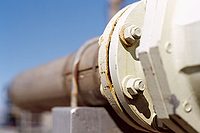Thermal Coating Replaces Insulation, Eliminates CUI

Image courtesy of Sherwin-Williams.
Heat-Flex® Advanced Energy Barrier (AEB) tackles corrosion under insulation (CUI), effectively eliminating the costly and dangerous phenomenon of steel assets corroding underneath insulation systems. The coating replaces the bulky mineral-based insulation traditionally used on storage tanks, process vessels and piping to retain process heat. By eliminating the threat of corrosion, the coating offers a solution that is less resource intensive than traditional insulating production systems.
“To occur in the first place, corrosion under insulation requires the presence of one of its namesakes – the insulation. By removing this ‘I’ from an asset and applying the thermal insulative coating in its place, there is no longer any physical system under which the ‘C’ – the corrosion – could occur,” said Neil Wilds, global product director, CUI/testing for Sherwin-Williams Protective & Marine. “Therefore, the corrosion is eliminated by default. With Heat-Flex AEB, we’re kissing both insulation and CUI goodbye.”
The coating works by building a thick film of insulative material onto assets required to maintain operating temperatures up to 350 °F (177 °C), with excursions to 400 °F (204 °C). This approach retains process heat inside coated assets, allowing them to continue operating even in extreme environments. It effectively rivals the in-service insulative capabilities of traditional insulation systems due to their tendency to absorb and trap moisture that infiltrates their exterior cladding. This moisture not only dramatically reduces the insulating capacity of the insulation but also contributes to the acceleration of CUI.
“When developing Heat-Flex AEB, we needed to ensure the coating itself could retain process heat at temperatures high enough to remove traditional insulation and not affect the consistency and flow of materials housed inside assets,” said Erik Dammen-Brower, R&D chemist II for Sherwin-Williams Protective & Marine. “Careful manipulation of the coating molecule and product formulation enabled this surprising capability, which has notable ramifications for reducing costs and improving carbon footprints, while enabling efficiencies in various facility applications.”
 Image courtesy of Sherwin-Williams.
Image courtesy of Sherwin-Williams.Beyond the comparable heat retention capabilities of traditional insulation systems, the thermal barrier coating offers a variety of enhanced sustainability benefits. Using just the insulative coating eliminates the manufacturing, shipping and storage of all the materials required for a traditional system – including the mineral wool insulation, wiring, pins and banding that keeps insulation in place, and the metal cladding mounted over top. In addition, because the coating eliminates CUI, steel assets will last far longer before any steel needs to be replaced, if at all, minimizing the environmental costs of steel production to maintain an asset. Finally, the consistent thermal efficiency the coating offers allows asset owners to maintain required operating temperatures without needing to increase process heat inside the coated asset. Owners may need to increase that heat – and therefore their environmental footprints – when using traditional insulation systems due to the inevitable moisture ingress that will occur and reduce the insulation’s effectiveness.
A typical CUI-elimination coating system includes a primer applied directly to prepared steel to protect it from corrosion, the insulative coating on top of that, and an optional topcoat layer. Recommended primers include Heat-Flex 750, a high-solids alkylated amide epoxy coating featuring a high concentration of micaceous iron oxide pigment, as well as Heat-Flex ACE, an ultra-high-solids epoxy novolac containing a functional chemical enhancement for CUI mitigation. Each primer performs extremely well against CUI when used underneath traditional insulation systems, making them even better options when no insulation is present.
Applying the thermal barrier coating is significantly easier, faster and safer than installing bulky insulation systems over assets. Such installations require workers to wrap, band and cover insulation while in close proximity to hot assets. A single applied coat will instantaneously reduce the surface temperature, taking away the burn risk. Those assets can be operating up to 300 °F (148 °C) during coating applications, enabling processes to continue running without disrupting facility operations, which is helpprotectsful for maintenance activities. Being in such close vicinity to hot steel significantly elevates burn risk potential. Applicators are able to stay farther away from hot assets when spraying the coating. Applications on new components can also take place in on-site pre-assembly yards rather than after assets are fully assembled – unlike with most traditional insulation applications, since those assets would be difficult to transport when fully insulated.
For more information, visit the Heat-Flex AEB product page.
Looking for a reprint of this article?
From high-res PDFs to custom plaques, order your copy today!






